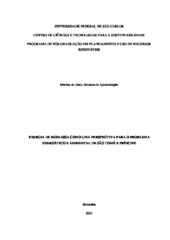| dc.contributor.author | Apresentação, Marcos de Jesus Fonseca de | |
| dc.date.accessioned | 2021-03-22T16:55:59Z | |
| dc.date.available | 2021-03-22T16:55:59Z | |
| dc.date.issued | 2021-03-03 | |
| dc.identifier.citation | APRESENTAÇÃO, Marcos de Jesus Fonseca de. Energia de biomassa como uma perspectiva para o problema energético e ambiental de São Tomé e Príncipe. 2021. Dissertação (Mestrado em Planejamento e Uso de Recursos Renováveis) – Universidade Federal de São Carlos, Sorocaba, 2021. Disponível em: https://repositorio.ufscar.br/handle/ufscar/14012. | * |
| dc.identifier.uri | https://repositorio.ufscar.br/handle/ufscar/14012 | |
| dc.description.abstract | Among renewable energies, bioenergy is the one with the greatest participation in the global
energy mix, corroborating with the various studies carried out in the area. Today, in the scopus
search string alone, there are about 31,000 scientific articles in the field. To analyze the large
amount of literature in the area, the method of systematic bibliographic review (RBS) was used.
The objective of the first article was to understand the bioenergy scenario, answering the 4
questions: What is the bioenergy scenario in the World and in Africa; What are the main
cultures used; Which harness technologies are being employed; What are the main benefits and
implications that its use brings. For this, the model proposed by Conforto et al. (2011). The
results show that, since the year 2000, bioenergy has been promoted as an alternative source of
energy and has become part of the policy, which has led to the continuous growth of research.
Currently, research around the world is focused on carbon dioxide capture and storage
bioenergy (BECCS) and scenario analysis. As for the African continent, although the
government is interested in modern bioenergy and in the implementation of several projects
related to bioenergy, traditional biomass is still the main source of energy. The cause of this
problem is the lack of clear policies and coordination with researchers. Regarding the third
question, the most used raw materials are: waste, forest, wood, sugar cane, seaweed, jatobá, oil
palm, grass, corn, coal, miscanthus. The use of these raw materials for bioenergy brings many
benefits, such as: gender equality, reduction of social inequality, improvement of living
conditions, income generation, sustainable economic development, reduction of deforestation,
reduction of air pollution and better destination of these waste. Pondering these benefits, the
objective of the second article was to analyze the bioenergetic potential of the main energy
cultures of São Tomé and Príncipe and to point out some of the benefits that may arise from
their use. For this calculation, the formula proposed by the Bioenergy Atlas of Brazil in 2012
was used, obtaining an energy potential of 4.5 GW / year, where 80% of this potential was from
two cocoa and banana crops. Considering the potential of these two cultures, the third article
proposed the manufacture of briquettes. For this, norms of ISO, NBR of ABNT were adapted,
for the immediate analysis and for the other performed analyzes. It was found that it is possible
to produce briquettes with these two cultures, without the use of binder and temperature. São
Tomé and Príncipe can benefit greatly from bioenergy, increasing the share of renewable energy
in its electrical matrix, decreasing the dependence on imported diesel, reducing losses indistribution by installing small decentralized systems and other benefits mentioned throughout
this work. | por |
| dc.description.sponsorship | Coordenação de Aperfeiçoamento de Pessoal de Nível Superior (CAPES) | por |
| dc.language.iso | por | por |
| dc.publisher | Universidade Federal de São Carlos | por |
| dc.rights | Attribution-NonCommercial-NoDerivs 3.0 Brazil | * |
| dc.rights.uri | http://creativecommons.org/licenses/by-nc-nd/3.0/br/ | * |
| dc.subject | África | por |
| dc.subject | Energia | por |
| dc.subject | Desenvolvimento | por |
| dc.subject | Resíduos | por |
| dc.subject | Bioenergia | por |
| dc.subject | Energy | por |
| dc.subject | Development | por |
| dc.subject | Waste | por |
| dc.subject | Bioenergy | por |
| dc.title | Energia de biomassa como uma perspectiva para o problema energético e ambiental de São Tomé e Príncipe | por |
| dc.title.alternative | Biomass energy as a perspective for the energetic and environmental problem of São Tomé and Príncipe | por |
| dc.type | Dissertação | por |
| dc.contributor.advisor1 | Yamaji, Fábio Minoru | |
| dc.contributor.advisor1Lattes | http://lattes.cnpq.br/4787449634914831 | por |
| dc.contributor.advisor-co1 | Silva, Diogo Aparecido Lopes | |
| dc.contributor.advisor-co1Lattes | http://lattes.cnpq.br/1101747760784249 | por |
| dc.description.resumo | Dentre as energias renováveis, a bioenergia é a com maior participação no mix energético
global, corroborando com os vários estudos realizados na área. Hoje, apenas na string de
pesquisa scopus, existem cerca de 31.000 artigos científicos na área. Para analisar a grande
quantidade de literatura na área, foi utilizado o método de revisão bibliográfica sistemática
(RBS). O objetivo do primeiro artigo foi compreender o cenário da bioenergia, respondendo as
4 perguntas: Qual o cenário da bioenergia no Mundo e na África; Quais as principais culturas
usadas; Quais as tecnologias de aproveitamento estão sendo empregadas; Quais são os
principais benefícios e implicações que trazem a sua utilização. Para isso, aplicou-se o modelo
proposto por Conforto et al. (2011). Os resultados mostram que, desde o ano 2000, a bioenergia
impulsionou-se como fonte alternativa de energia e passou a fazer parte da política, o que tem
levado ao contínuo crescimento das pesquisas. Atualmente, as pesquisas no mundo estão
focadas em bioenergia de captura e armazenamento de dióxido de carbono (BECCS) e na
análise de cenários. Quanto ao continente africano, embora o governo esteja interessado na
bioenergia moderna e na implementação de diversos projetos referentes a bioenergia, a
biomassa tradicional ainda é a principal fonte de energia. A causa deste problema é a falta de
políticas claras e a articulação com os pesquisadores. Em relação à terceira pergunta, as matérias
primas mais utilizadas são: resíduos, floresta, madeira, cana de açúcar, alga, jatobá, dendê,
capim, milho, carvão, miscanthus. O uso dessas matérias primas para bioenergia traz muitos
benefícios, tais como: igualdade de gênero, diminuição da desigualdade social, melhoria das
condições de vida, geração de renda, desenvolvimento econômico sustentável, redução dos
desmatamentos, diminuição da poluição do ar e melhor destinação desses resíduos. Ponderando
estes benefícios, o objetivo do segundo artigo foi analisar o potencial bioenergético das
principais culturas energéticas de São Tomé e Príncipe e apontar alguns dos benefícios que
podem advir da sua utilização. Para esse cálculo, foi utilizada a fórmula proposta pelo Atlas de
Bioenergia do Brasil de 2012, obtendo-se um potencial energético de 4,5 GW/ano, onde 80%
desse potencial, foram de duas culturas de cacau e banana. Considerando o potencial destas
duas culturas, no terceiro artigo foi proposto a fabricação de briquetes. Para isso, adaptou-se
normas da ISO, NBR da ABNT, para a análise imediatas e para as demais análises realizadas.
Constatou-se que é possível produzir briquetes com essas duas culturas, sem o uso de
aglutinante e temperatura. São Tomé e Príncipe pode beneficiar muito com a bioenergia,
aumentando a participação da energia renováveis na sua matriz elétrica, diminuindo a dependência do diesel importado, diminuindo as perdas na distribuição instalando pequenos
sistemas decentralizados e outros benefícios mencionados ao longo deste trabalho. | por |
| dc.publisher.initials | UFSCar | por |
| dc.publisher.program | Programa de Pós-Graduação em Planejamento e Uso de Recursos Renováveis - PPGPUR-So | por |
| dc.subject.cnpq | CIENCIAS AGRARIAS::RECURSOS FLORESTAIS E ENGENHARIA FLORESTAL::ENERGIA DE BIOMASSA FLORESTAL | por |
| dc.publisher.address | Câmpus Sorocaba | por |
| dc.contributor.authorlattes | http://lattes.cnpq.br/7574353788654033 | por |


